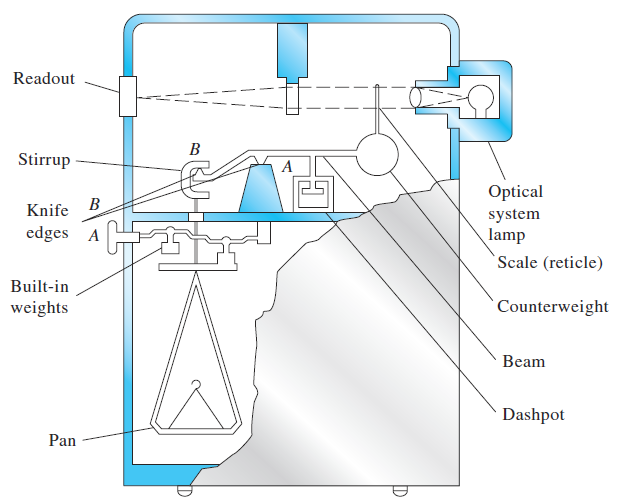
The Single-Pan Mechanical Analytical Balance Components
 المؤلف:
D. A. Skoog, F. J.Holler, D M. West, and S. R. Crouch
المؤلف:
D. A. Skoog, F. J.Holler, D M. West, and S. R. Crouch
 المصدر:
Fundamentals of Analytical Chemistry
المصدر:
Fundamentals of Analytical Chemistry
 الجزء والصفحة:
9th. p 21
الجزء والصفحة:
9th. p 21
 16-4-2017
16-4-2017
 8552
8552
The Single-Pan Mechanical Analytical Balance Components
Although the single-pan mechanical balance is no longer manufactured, many of these rugged and reliable devices are still found in laboratories. We include a description of this balance for reference and historical purposes. Figure 1.1 is a diagram of a typical single-pan mechanical balance. Fundamental to this instrument is a lightweight beam that is supported on a planar surface by a prism-shaped knife edge (A).

Figure 1.1 Single-pan mechanical analytical balance. [Reprinted (adapted) with permission from R. M. Schoonover, Anal. Chem., 1982, 54, 973A. Published 1982, American Chemical Society.]
Attached to the left end of the beam is a pan for holding the object to be weighed and a full set of masses held in place by hangers. These masses can be lifted from the beam one at a time by a mechanical arrangement that is controlled by a set of knobs on the exterior of the balance case. The right end of the beam holds a counterweight of such size as to just balance the pan and masses on the left end of the beam.
A second knife edge (B) is located near the left end of the beam and support as a second planar surface, which is located in the inner side of a stirrup that couples the pan to the beam. The two knife edges and their planar surfaces are fabricated from extremely hard materials (agate or synthetic sapphire) and form two bearings that permit motion of the beam and pan with a minimum of friction. The performance of a mechanical balance is critically dependent on the perfection of these two bearings.
Single-pan balances are also equipped with a beam arrest and a pan arrest. The beam arrest is a mechanical device that raises the beam so that the central knife edge no longer touches its bearing surface and simultaneously frees the stirrup from contact with the outer knife edge. The purpose of both arrest mechanisms is to prevent damage to the bearings while objects are being placed on or removed from the pan.
When engaged, the pan arrest supports most of the mass of the pan and its contents and thus prevents oscillation. Both arrests are controlled by a lever mounted on the outside of the balance case and should be engaged whenever the balance is not in use.
An air damper (also known as a dashpot) is mounted near the end of the beam opposite the pan. This device consists of a piston that moves within a concentric cylinder attached to the balance case. Air in the cylinder undergoes expansion and contraction as the beam is set in motion. The beam rapidly comes to rest as a result of this opposition to motion. To discriminate between small differences in mass (,1 mg), analytical balances must be protected from air currents. These devices are always enclosed in cases with doors so that samples can be placed on the pan for weighing and removed when weighing is complete.
 الاكثر قراءة في مواضيع عامة في الكيمياء التحليلية
الاكثر قراءة في مواضيع عامة في الكيمياء التحليلية
 اخر الاخبار
اخر الاخبار
اخبار العتبة العباسية المقدسة


